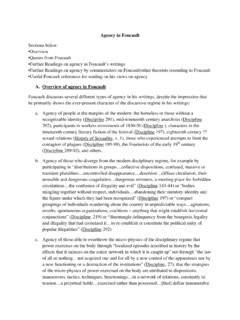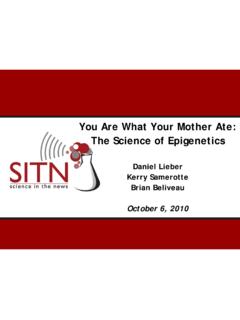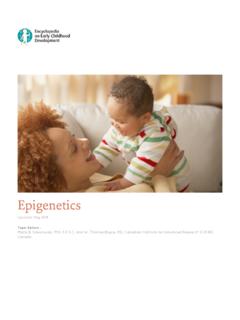Transcription of Behavioral Genetics, Genetics, and Epigenetics - Oxford ...
1 Print Publication Date: Mar 2013 Subject: Psychology, Developm ental PsychologyOnline Publication Date: Dec 2013 DOI: Genetics, Genetics, and EpigeneticsDavid S. MooreThe Oxford Handbook of Developmental Psychology, Vol. 1: Body and MindOxford Handbooks OnlineAbstract and KeywordsWhen considering how nature and nurture contribute to development, psychologists often take the former to mean influenced by genes. Traditionally, Behavioral geneticists have used twin and adoption studies to assess the extent of genetic influence on various behaviors. Recently, theheritability statistics these studies generate have been criticized as meaningless, partly because biologists have established that genes cannotinfluence development independently of environmental factors; genetic and nongenetic factors always cooperate to build traits.
2 This chapter considersgenetic contributions to some psychological characteristics, thereby demonstrating what genes can and cannot do. New discoveries regarding thecontrol of genes via epigenetic mechanisms are of interest to developmental psychologists because they have the potential to reveal howenvironments and genes interact, help us understand certain Behavioral disorders, and illuminate normal psychological processes like learning andmemory; in addition, they cast doubt on the neo-Darwinian dogma that ancestors experiences cannot influence descendants development. Advancesin genetics have clarified how molecular factors contribute to psychological characteristics and indicated that all of our characteristics are influencedby developmental : development, nature nurture, developmental systems, heredity, heritability, genes and behavior, Epigenetics and behavior, epigenetic inheritance, gene-by-environment interactionsKey Points1.
3 In building traits during development, genes operate collaboratively with nongenetic biological factors (many of which are influenced byenvironmental factors). Therefore, neither biological, psychological, nor pathological characteristics can be accurately labeled genetic ( ,genetically determined); genetic abnormalities do not even straightforwardly cause the symptoms of monogenic disorders like cystic fibrosis,Huntington s disease, or phenylketonuria. Nonetheless, the development of all of our characteristics is influenced by Understanding that phenotypes are built during development as genetic factors interact with nongenetic factors draws attention to thedevelopmental processes that are actually responsible for the phenotypes and thereby highlights multiple points in the developmental systemwhere interventions could be Genes do not exist in a coherent state in our bodies.
4 Rather, unedited and ambiguous segments of DNA are cut, mixed, and recombined in acontext-dependent way to produce temporary edited molecules that represent how genetic information is actually Twin studies and the heritability statistics they generate cannot illuminate the extent to which genetic versus environmental factors contributeto the development of traits in individuals. Furthermore, in normal developmental circumstances, heritability estimates are not measures of howinheritable phenotypes are. Finally, because traits that are perfectly heritable in one context can be profoundly influenced by environmentalfactors in other contexts, heritability estimates do not reflect how easily a phenotype can be influenced by an environmental The heritability of a characteristic tells us about a population that has been studied, not about the characteristic itself.
5 In part, this is becauseheritability estimates always reflect the amount of variation present in the environments of the population being Heritability estimates do not enable meaningful comparisons of (a) individuals to groups, (b) groups to other groups, or (c) traits to other , they do not enable functional interventions in Environmental factors affect what genes do, either directly (as happens with immediate-early genes) or indirectly (as when, for example,environmental events influence hormone concentrations that in turn influence gene expression). Thus, genes are better thought of as reactive thanas genetic and epigenetic research is illuminating the operation of normal psychological functions such as learning and memory, as well as theorigins of some Behavioral disorders.
6 Pharmacological interventions that target epigenetic marks have already been found able to improvememory in Studies that have found statistical interactions between genes and developmental experiences ( , Caspi et al., 2002, 2003) have nottypically studied the actual causal mechanical interplay known to characterize gene environment interaction. Therefore, any future failures to findstatistical interactions in these sorts of studies would not mean that genetic factors and environmental factors do not interact to produce thephenotypes in A lifetime of experiences leaves epigenetic marks on our genomes, altering how and even if our genes are expressed. Because genes canbe epigenetically upregulated or downregulated, what matters is not simply whether an individual has particular genes, but rather what thatindividual s genes are or are not being induced to In rats, specific maternal behaviors directed toward newborn offspring have been found to epigenetically influence the offspring s stressBehavioral Genetics, Genetics, and EpigeneticsPR IN TED FR OM OXFOR D H AN D BOOKS ON LIN E ( ).
7 (c) Oxford U niversity Press, 2013. All R ights R eserved. U nder theterms of the licence agreement, an individual user may print out a PD F of a single chapter of a title in Oxford H andbooks Online for personal use (fordetails see Privacy Policy).Subscriber: Oxford U niversity Press - Master G ratis Access; date: 22 D ecember 2013reactivity into adulthood; seemingly analogous phenomena have been reported in human populations. Certain drugs appear able to alterepigenetic states in rats in ways that eliminate the increased stress reactivity caused by exposure to these maternal behaviors; thus, epigeneticmodifications produced by life experiences have proven to be experimentally Epigenetic modifications acquired by at least some mammals during development can be transmitted to descendant generations.
8 Thisdiscovery will force a rethinking of the neo-Darwinian concept of inheritance, as theorists work to construct a unified theory of phenotypes thatencompasses both evolutionary and developmental regarding the origins of our characteristics are the proper domain of developmentalists, and developmental psychologists have beenmotivated by these questions from the outset. As early as 1582, a teacher named Richard Mulcaster used the words nature and nurture whendescribing the factors that influence the development of children (West & King, 1987), but it was not until 1869 that Francis Galton conducted whatmany consider to be the first studies that attempted to address these questions scientifically (Plomin, 1994).
9 Although the notion of genes had not yetappeared on the scientific stage, Galton s conceptualization of the relationship between nature and nurture formed the theoretical foundations of thebranch of psychology that ultimately came to be known as quantitative Behavioral genetics, and as the twentieth century brought advances inmolecular biology, the idea that some of our characteristics could be explained with reference to genes became modern field of Behavioral genetics takes two decidedly different approaches to the study of how genes contribute to behavior. For most of thetwentieth century, Behavioral genetics was understood to be the branch of population genetics (one of biology s subdisciplines) that was devoted tousing population-genetics methods to explore how genes contribute to behaviors; this approach still characterizes a subdiscipline of psychology nowknown as quantitative Behavioral genetics.
10 In contrast, a newer approach to the study of how genes contribute to behavior, known as molecularbehavioral genetics, has grown out of molecular biology, a branch of biology devoted to exploring the structure and function of biological moleculessuch as DNA. Because this chapter is focused on psychological/ Behavioral phenomena, the word genetics in the title can be taken to refer tomolecular Behavioral genetics, whereas the words Behavioral genetics in the title in keeping with the historical use of these words can be taken torefer to quantitative Behavioral the end of the twentieth century, a map of the genome of a human being had been published for the first time (see International Human GenomeSequencing Consortium, 2001; Venter et al.)












